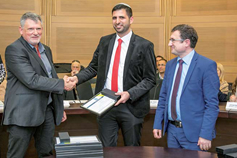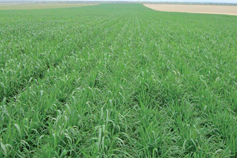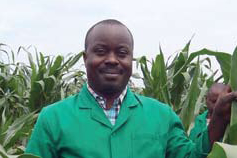Mr. Yariv Kedar
Cereals Magazine: Since Inception, Briefly discuss GreenArava
 Yariv: When we started GreenArava, the company was predominantly known for Galana Kulalu. We were very much a, one-product business. Immediately, we did a critical analysis of the business to see where to from here, and it was quite clear that we needed to expand our base in terms of product range, branding, and channels of sale.
Yariv: When we started GreenArava, the company was predominantly known for Galana Kulalu. We were very much a, one-product business. Immediately, we did a critical analysis of the business to see where to from here, and it was quite clear that we needed to expand our base in terms of product range, branding, and channels of sale.
We made sure that we had a good, strong brand, and the idea was to grow the GreenArava brand and move it interstate through the normal market channel and also through the alternative market and the independent market. That was probably the first major step for us in getting ourselves known across the region.
The other key strategy was product portfolio expansion. There were clearly a number of opportunities in the value-added, agricultural product category—whether that’s with designs, development or implementing turnkey agricultural projects, as well as a whole bunch of other opportunities that hadn’t been thought about. We ventured in water and sanitation, greenhouse technology, crop protection, trainings and consultancy, small and medium level irrigation projects. Immediately, we started our value-added business and we have been quietly growing that in the background.
Read more ...
Shaping The Future of Farming
 Last year I managed to follow the Future of Farming Dialog 2017, an annual event hosted by the Crop Science division of Bayer, which brings together approximately 250 opinion leaders, stakeholders and media in an open forum to discuss the important issues facing food and agriculture today and in the future. I believe last year’s conference set the right tone to address one of the most important questions of our time: How to feed a growing population in an environmentally sustainable way?
Last year I managed to follow the Future of Farming Dialog 2017, an annual event hosted by the Crop Science division of Bayer, which brings together approximately 250 opinion leaders, stakeholders and media in an open forum to discuss the important issues facing food and agriculture today and in the future. I believe last year’s conference set the right tone to address one of the most important questions of our time: How to feed a growing population in an environmentally sustainable way?
When it comes to the energy that sustains us, we’re up against significant challenges to ensure an adequate supply of safe, nutritious and affordable food now and in future. By 2050, we will need to feed an additional three billion people, requiring an increase in food production by 50%. This significant growth in demand, coupled with ongoing environmental degradation, a lack of arable land and a changing climate, means that more – not less – science and innovation is needed to meet the needs of the future. But producing more food is only half the battle. We also must be able to produce food more sustainable, so that we can preserve our limited natural resources for generations to come.
Read more ...
 Direct communication is key: Kenya’s Future of Farming requires a platform for agriculture industry professionals to discuss what the future of farming requires and how the youth can contribute to sustainable agriculture.
Direct communication is key: Kenya’s Future of Farming requires a platform for agriculture industry professionals to discuss what the future of farming requires and how the youth can contribute to sustainable agriculture. Yariv: When we started GreenArava, the company was predominantly known for Galana Kulalu. We were very much a, one-product business. Immediately, we did a critical analysis of the business to see where to from here, and it was quite clear that we needed to expand our base in terms of product range, branding, and channels of sale.
Yariv: When we started GreenArava, the company was predominantly known for Galana Kulalu. We were very much a, one-product business. Immediately, we did a critical analysis of the business to see where to from here, and it was quite clear that we needed to expand our base in terms of product range, branding, and channels of sale. Last year I managed to follow the Future of Farming Dialog 2017, an annual event hosted by the Crop Science division of Bayer, which brings together approximately 250 opinion leaders, stakeholders and media in an open forum to discuss the important issues facing food and agriculture today and in the future. I believe last year’s conference set the right tone to address one of the most important questions of our time: How to feed a growing population in an environmentally sustainable way?
Last year I managed to follow the Future of Farming Dialog 2017, an annual event hosted by the Crop Science division of Bayer, which brings together approximately 250 opinion leaders, stakeholders and media in an open forum to discuss the important issues facing food and agriculture today and in the future. I believe last year’s conference set the right tone to address one of the most important questions of our time: How to feed a growing population in an environmentally sustainable way? Bayer East Africa has re-affirmed its commitment to the government’s big four agenda though their contribution to food security by ensuring innovations in agriculture –by way of employing technology combined with talent to deliver value to both customers and partners.
Bayer East Africa has re-affirmed its commitment to the government’s big four agenda though their contribution to food security by ensuring innovations in agriculture –by way of employing technology combined with talent to deliver value to both customers and partners. Many farmers have begun to use multiple actions to combat herbicide resistance and are on the cusp of good weed management. But, herbicide resistance continues to grow, and at an increasing rate. Multiple resistance is becoming the norm, with no new mode of action on the horizon for 15 to 20 years, research and development companies will need more time, thought, and money will be needed to control weeds in the future.
Many farmers have begun to use multiple actions to combat herbicide resistance and are on the cusp of good weed management. But, herbicide resistance continues to grow, and at an increasing rate. Multiple resistance is becoming the norm, with no new mode of action on the horizon for 15 to 20 years, research and development companies will need more time, thought, and money will be needed to control weeds in the future.